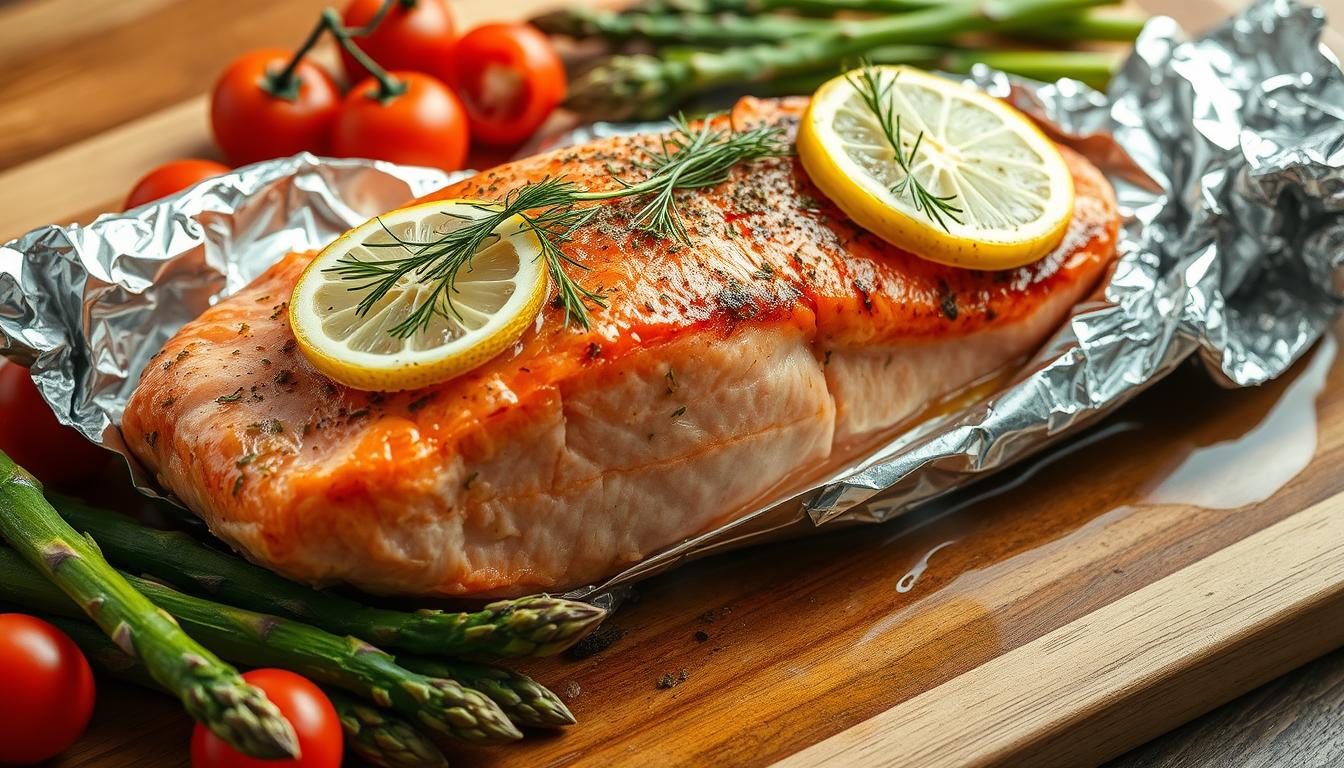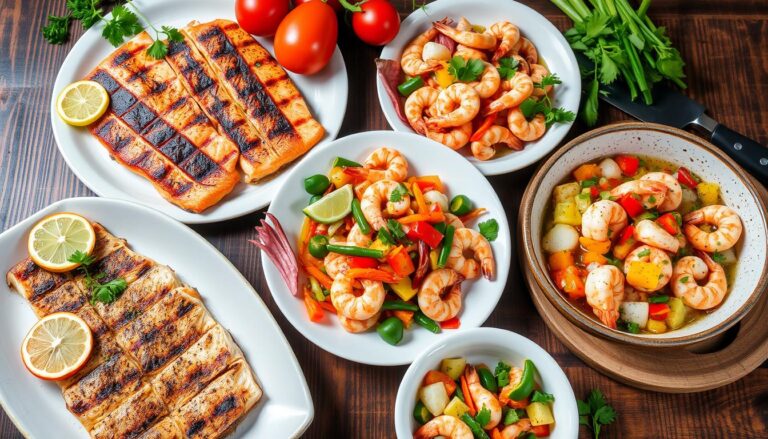Baked Salmon Recipe Foil – Easy, Juicy, and Delicious
It’s a busy weeknight, and you’re looking for a quick yet tasty meal. You want something that’s not only satisfying but also healthy. Baking salmon in foil is the perfect solution. It results in moist and flaky salmon that everyone will love.
This recipe is quick to prepare, taking just 10 minutes. It cooks in under 30 minutes, making it a favorite for many. The aroma and colors of the ingredients make it more than just a meal. It’s an experience that brings your family together.
Choosing this dish means you’re enjoying a healthy meal rich in protein. It opens up a world of culinary possibilities in your kitchen. Let’s explore why baking salmon in foil is a great choice for your next meal.
Table of Contents
Introduction to Baking Salmon in Foil
Baking salmon in foil is a simple way to get delicious, juicy results. It seals in moisture and boosts flavor. This method is great for both new and seasoned cooks.
Many people find it hard to keep salmon moist and avoid overcooking. Foil helps by creating a steam pocket. With proper preparation, you can make oven-baked salmon in foil tender and flavorful every time.
Why Use Foil for Baking Salmon?
Baking salmon in foil has many benefits. It keeps the fish moist and makes cleanup easy. These factors are key to a great dish, like a foil baked salmon recipe.
Moisture Retention
Foil traps steam, keeping the salmon moist. This is great for leaner wild salmon, preventing it from drying out. You get a juicy, flavorful fish that stays tender.
Even Cooking
Foil cooks the salmon evenly, without the need to flip. This avoids uneven textures. You end up with flaky fish that tastes amazing.
Easy Cleanup
Cooking with foil makes cleanup a breeze. Just throw away the foil after your meal. This saves you time and effort, letting you enjoy your meal more.
| Benefit | Explanation |
|---|---|
| Moisture Retention | Traps steam to keep salmon juicy |
| Even Cooking | Distributes heat uniformly for perfectly flaky fish |
| Easy Cleanup | Eliminates scrubbing; just discard the foil |
Ingredients You’ll Need
Creating delicious healthy baked salmon foil dishes starts with the right ingredients. Paying attention to details enhances flavor and makes the meal nutritious. Here are the key components for your salmon preparation.
Salmon Fillet Selection
Choosing the right salmon is key for a tasty dish. Opt for high-quality, wild-caught salmon for better flavor. Use about 2 pounds of salmon, cut into six 5-ounce or eight 4-ounce pieces for a satisfying meal.
The type of salmon you choose affects cooking time. Wild salmon cooks faster because it’s leaner.
Essential Seasonings
Simple seasonings like garlic, olive oil, salt, pepper, and lemon juice are crucial. Using fresh ingredients boosts flavor and healthiness. These few ingredients can make the salmon taste amazing.
Healthier Choices
Healthy baked salmon foil cooking uses little fat but keeps the taste rich. This method keeps the salmon moist and flavorful without too much oil or butter. It lets you enjoy the salmon’s natural taste while staying healthy.
| Ingredient | Purpose | Type |
|---|---|---|
| Salmon Fillet | Main protein source | Wild-caught preferable |
| Olive Oil | Add moisture and richness | Healthy fat |
| Salt | Enhances flavor | Essential seasoning |
| Pepper | Adds spice | Essential seasoning |
| Garlic | Boosts flavor | Fresh herb |
| Lemon Juice | Brightens flavor | Fresh ingredient |
| Herbs (optional) | Additional flavor | Fresh or dried |
Using these ingredients can change how you enjoy salmon. For more variety, try baked chicken meatballs in your meals.
How to Bake Salmon in Foil
Learning to bake salmon in foil can boost your cooking skills. This method keeps flavors in and moisture in, making your meal tasty and healthy. Follow these steps and techniques for the best results.
Preparation Steps
First, preheat your oven to 375°F. Then, line a baking sheet with foil, overlapping it to cover your salmon. Add parchment paper under the salmon to prevent sticking and make cleanup easier. Season your salmon with your favorite spices and a bit of salt. Wrap the salmon tightly in foil to keep moisture and flavor in.
Cooking Techniques
Place your salmon on the baking sheet and put it in the oven. Cook a 1.5-inch thick salmon for 15 to 18 minutes. Thinner pieces might need 10 to 12 minutes. Check for an internal temperature of 125°F to 130°F for tender salmon. The FDA recommends cooking to 145°F for safety. Your salmon is done when it’s opaque, juicy, and has a bright pink center.
For more cooking ideas, check out this recipe for Alice Springs Chicken. It uses similar cooking methods and flavors.
Baked Salmon Recipe Foil – A Step-by-Step Guide
Cooking salmon in foil makes it taste better and keeps it moist. This guide will show you how to wrap the salmon and cook it right. You’ll get a tasty baked salmon recipe every time.
Wrapping the Salmon
Begin by wrapping your salmon fillet in parchment paper, then foil. This keeps flavors in and prevents aluminum from affecting the food. It also makes cleaning up easier.
Cooking Temperatures and Times
1. Preheat your oven to 375°F (190°C). This is the best temperature for cooking salmon in foil.
2. The cooking time depends on the salmon’s thickness. For a 1.5-inch thick piece, bake for 15 to 18 minutes. Wild salmon cooks faster, while farmed takes longer. Here’s a general guide:
| Thickness | Cooking Time |
|---|---|
| 1 inch | 12-15 minutes |
| 1.5 inches | 15-18 minutes |
| 2 inches | 20-25 minutes |
Always check the salmon’s internal temperature. The FDA says it should be at least 145°F (63°C). For the best texture, aim for 125°F to 130°F. This makes the salmon flaky, moist, and tender with a bright pink center.
Tips for Achieving the Best Results
Getting the most out of baked salmon requires a few key techniques. These methods enhance flavors and make for a great meal. By following these tips, you can find the best baked salmon recipe that fits your taste.
Do Not Overcook
Overcooking salmon makes it dry, which is not good. Learn to know when it’s done, usually when it flakes with a fork. Try the simple baked salmon foil packets method for a perfect cook time of 12 to 15 minutes at 450°F.
Using Fresh Ingredients
Fresh herbs and spices make a big difference in taste. Fresh garlic and herbs add bright flavors that processed ones can’t match. Always choose fresh ingredients for the best taste in your salmon.
Testing for Doneness
Checking if the salmon is done right is key for taste and safety. Use a meat thermometer to see if the thickest part hits 145°F. This method ensures your salmon is tasty and safe to eat, making your cooking worth it.
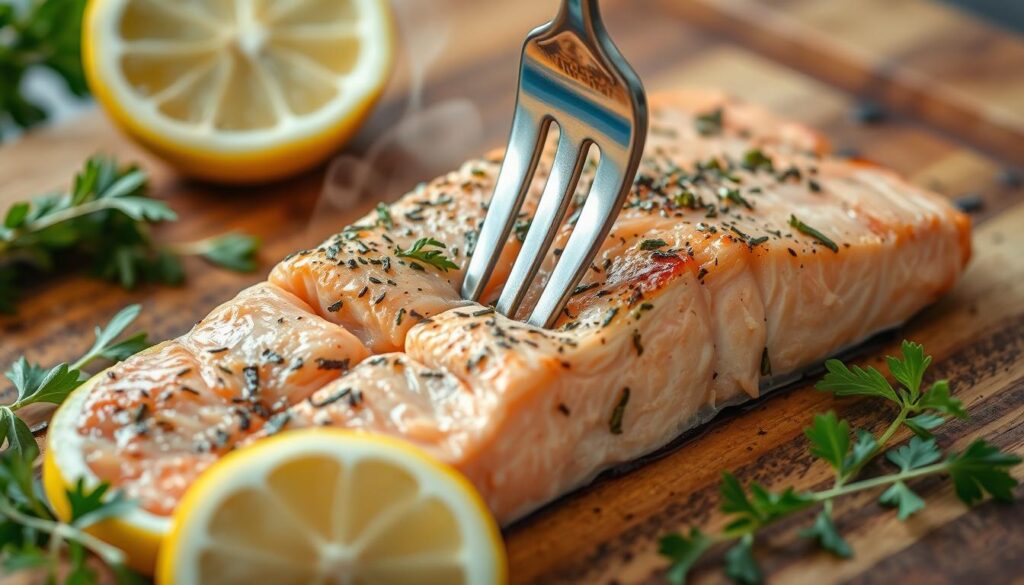
Fun Variations on Baked Salmon
Exploring different flavors can make your salmon foil pack recipe even better. You can try new things each time you cook. Here are some exciting options to add to your foil salmon recipe.
Pesto and Lemon Variation
Try pesto and lemon for a burst of flavor. Spread pesto on the salmon before wrapping it in foil. Add some fresh lemon zest on top for extra aroma. This mix makes the salmon taste richer and more aromatic.
Honey Garlic Option
Mix honey with garlic for a sweet and savory flavor. Drizzle it over the salmon before baking. The honey caramelizes, making a tasty glaze that goes well with the fish. This is one of the tastiest ways to enjoy salmon.
Spicy Salmon Topping
For a spicy kick, add chili flakes or a spicy glaze. Mix hot sauce with olive oil and brush it on. This spicy topping adds excitement and shows how versatile salmon can be.
What to Serve with Baked Salmon
When you’re cooking up a meal with baked salmon, picking the right sides can make it even better. Adding flavors and textures that match the salmon’s taste makes for a well-rounded meal. Here are some easy side dishes and healthy salads that go great with your salmon foil packet recipes.
Easy Side Dishes
Looking for simple side dishes can make cooking easier. Here are some tasty and nutritious options:
- Roasted asparagus seasoned with olive oil and garlic
- Quinoa mixed with fresh herbs and lemon zest
- Seasonal veggie medleys containing carrots, bell peppers, and zucchini
- Egg-fried rice, which cooks in under 15 minutes
- Mashed sweet potatoes for a touch of sweetness
These side dishes get high ratings, with some even getting a perfect 5 out of 5. They help you meet the 5-a-day nutrition goal, making your meal healthy.
Healthy Salad Pairings
Adding healthy salads to your meal can make it brighter and more nutritious:
- Arugula salad with feta cheese and a lemon vinaigrette
- Cucumber and tomato salad with a hint of red onion
- Spinach salad with walnuts and cranberries
These salads offer a refreshing contrast to the warm salmon and are low in fat. They’re perfect for adding nutrition to your meal, making it both tasty and healthy.
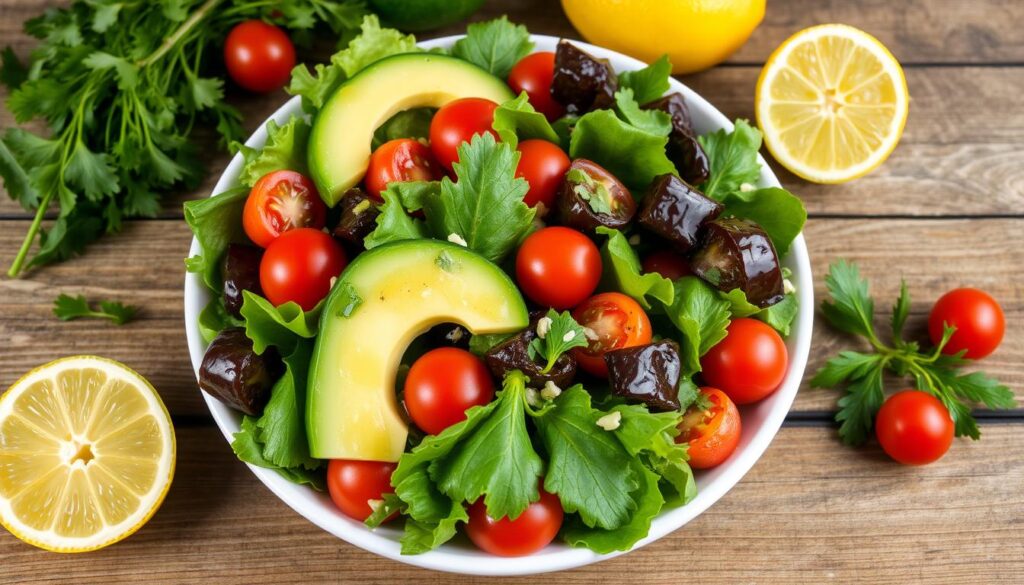
How to Store and Reheat Leftover Salmon
Leftover salmon needs careful handling to keep its taste and texture. When storing it, choose the right methods to ensure freshness. Proper storage of salmon baked in foil packets helps it stay good for later.
Storing Tips
Use an airtight container to store leftover salmon. This keeps air out and moisture in. Try to eat it within two days for the best taste. If you have too much, freeze it.
Freezing salmon in a safe container keeps it fresh for up to three months. Following these tips can make your meals better.
Reheating Methods
There are several ways to reheat leftover salmon. Here are a few:
- Oven: Preheat to 275°F to 300°F and heat for 10-15 minutes, ensuring even warming.
- Air Fryer: Set the temperature to 375°F for 5-7 minutes for a delightful crispy texture.
- Non-Stick Skillet: Heat salmon over medium heat for a few minutes, flipping halfway for even cooking.
- Microwave: Use medium power for 1-2 minutes, covering the salmon with a damp paper towel to keep moisture.
- Steaming: Position salmon over simmering water for 5-7 minutes to effectively rehydrate it.
Always check that the internal temperature reaches at least 145°F for safety. These reheating methods help your leftover salmon stay tasty, making every meal satisfying.
More Salmon Recipes to Explore
If you liked the baked salmon recipe, you might want to try more. Salmon is great for many dishes because it can take on different flavors. It’s perfect for adding excitement to your meals.
Grilled Salmon Ideas
Grilling salmon gives it a smoky taste. Cedar-planked salmon is a unique option. The cedar adds a sweet flavor to the fish.
Marinating the salmon in herbs and lemon before grilling is another great idea. It brings out the fish’s natural taste and lets you get creative with seasonings. For more ideas, check out this link.
Salmon in Different Cuisines
Salmon is a star in many cuisines. Try it with teriyaki or miso glazes for an Asian twist. These flavors pair well with salmon’s omega-3 benefits.
From Mediterranean salads to spicy curries, the options are endless. Expand your cooking skills with these recipes and more.
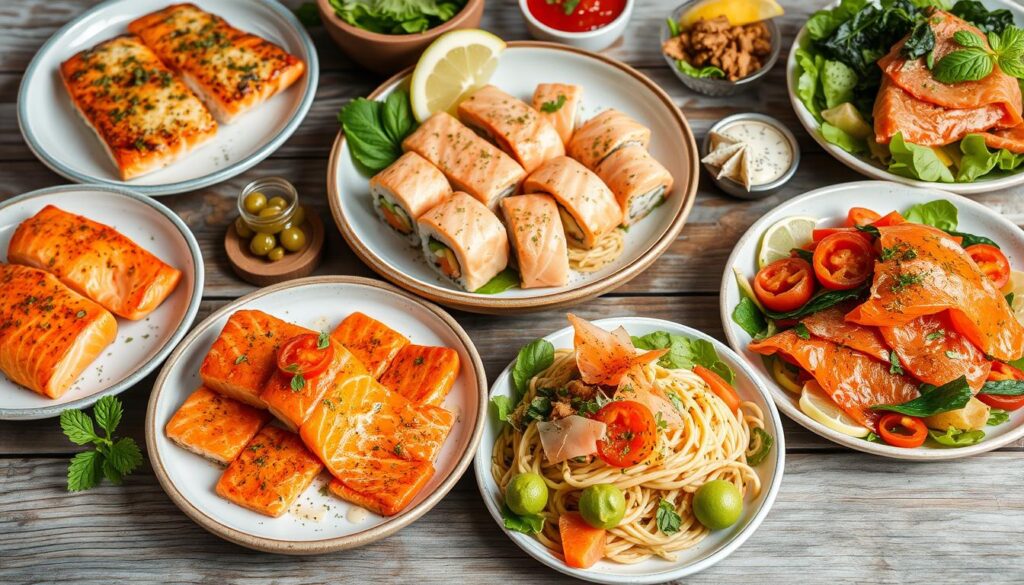
Conclusion
Learning to bake salmon in foil is a culinary adventure. It makes cooking salmon both tasty and easy. With a few ingredients and simple steps, you can make a salmon dish that wows everyone.
You can also add your favorite flavors like cherry tomatoes and Kalamata olives. This makes baking salmon in foil a healthy and flexible option. A sprinkle of Greek seasoning or a bit of balsamic vinegar can make it even better!
Trying out different flavors and serving ideas will boost your cooking confidence. Baking salmon in foil is quick and easy. So, get ready to try these recipes and make your dinner table special tonight! For a great meat dish to go with your salmon, check out this ground beef stroganoff recipe.

